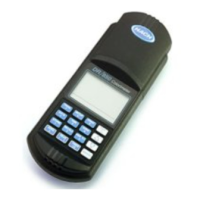112
4. Calculate the concentration of mg/L chlorine added to each
sample.
The spiked sample results should reflect the analyzed sample
result plus the calculated mg/L Cl
2
added to each sample. If these
increases do not occur, see Standard Additions in Section 1 of a
DR/800 Procedure Manual for more information.
Method Performance
Precision
In a single laboratory, using a chlorine standard solution of
5.05 mg/L Cl
2
and representative lots of reagent, a single
operator obtained a standard deviation of ± 0.05 mg/L Cl
2
.
Estimated Detection Limit
The estimated detection limit for Method 10070 is 0.05 mg/L Cl
2
.
For more information on the estimated detection limit, see
Section 1 of a DR/800 Procedure Manual.
Interferences
mg/L chlorine added
volume of standard added label value of Cl×
2
standard ampule
sample volume volume of standard added+
-------------------------------------------------------------------------------------------------------------------------------------------------------=
Interfering Substance Interference Levels and Treatments
Acidity Greater than 150 mg/L CaCO
3
. May not develop full color or color may fade
instantly.
1. Neutralize to pH 6–7 with 1 N Sodium Hydroxide.
2. Determine amount to be added on a separate sample aliquot, then add the
same amount to the sample being tested.
3. Correct for volume addition.
Alkalinity Greater than 250 mg/L CaCO
3
. May not develop full color or color may fade
instantly.
1. Neutralize to pH 6–7 with 1 N Sulfuric Acid.
2. Determine amount to be added on a separate sample aliquot, then add the
same amount to the sample being tested.
3. Correct for volume addition.
Bromine, Br
2
Interferes at all levels
Chlorine Dioxide, ClO
2
Interferes at all levels
Chloramines, organic May interfere
Iodine, I
2
Interferes at all levels
CHLORINE, TOTAL, Ultra-High Range, continued

